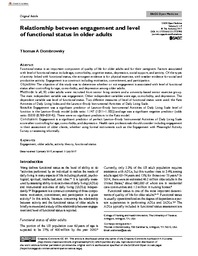| dc.contributor.author | Dombrowsky, Thomas A. | |
| dc.date.accessioned | 2018-05-07T23:35:09Z | |
| dc.date.available | 2018-05-07T23:35:09Z | |
| dc.date.issued | 2017 | |
| dc.identifier.citation | Published in SAGE Open Medicine 5: 1-9, 2017 | en_US |
| dc.identifier.uri | http://hdl.handle.net/10106/27326 | |
| dc.description.abstract | Functional status is an important component of quality of life for older adults and for their caregivers. Factors associated with level of functional status include age, comorbidity, cognitive status, depression, social support, and activity. Of the types of activity linked with functional status, the strongest evidence is for physical exercise, with weaker evidence for social and productive activity. Engagement is a construct including motivation, commitment, and participation.
Objective: The objective of this study was to determine whether or not engagement is associated with level of functional
status after controlling for age, comorbidity, and depression among older adults.
Methods: In all, 92 older adults were recruited from senior living centers and a university-based senior exercise group.
The main independent variable was engagement. Other independent variables were age, comorbidity, and depression. The dependent variable was level of functional status. Two different measures of level of functional status were used: the Katz Activities of Daily Living Index and the Lawton–Brody Instrumental Activities of Daily Living Scale.
Results: Engagement was a significant predictor of Lawton–Brody Instrumental Activities of Daily Living Scale level of
function in the Lawton–Brody model (odds ratio: 1.147 (1.011–1.302)) and age was a significant negative predictor (odds ratio: 0.838 (0.769–0.914)). There were no significant predictors in the Katz model.
Conclusion: Engagement is a significant predictor of perfect Lawton–Brody Instrumental Activities of Daily Living Scale
score after controlling for age, comorbidity, and depression. Health-care professionals should consider including engagement in their assessment of older clients, | en_US |
| dc.description.sponsorship | This research was supported by the Ferne Kyba Endowed Fellowship from the University of Texas at Arlington, College of Nursing and Health Innovation. | en_US |
| dc.language.iso | en_US | en_US |
| dc.publisher | Sage | en_US |
| dc.rights | Attribution 4.0 United States | * |
| dc.rights.uri | http://creativecommons.org/licenses/by/4.0/us/ | * |
| dc.subject | Functional status -- engagement | en_US |
| dc.subject | Older adults -- engagemenet | en_US |
| dc.subject | Older adults -- activity theory | en_US |
| dc.subject | Katz Activities of Daily Living Index | en_US |
| dc.subject | Lawton–Brody Instrumental Activities of Daily Living Scale | en_US |
| dc.title | Relationship between engagement and level of functional status in older adults | en_US |
| dc.type | Article | en_US |
| dc.publisher.department | College of Nursing and Health Innovation, The University of Texas Arlington | en_US |
| dc.identifier.externalLinkDescription | Original article available from article DOI | en_US |
| dc.identifier.doi | doi.org/10.1177/2050312117727998 | |


